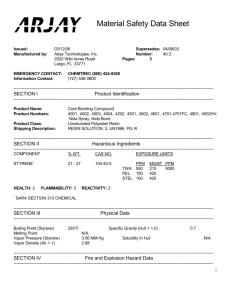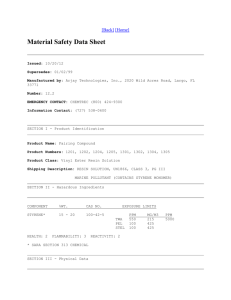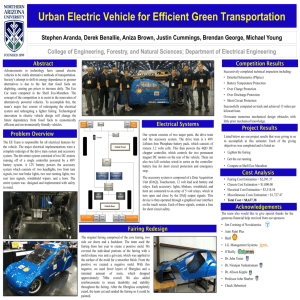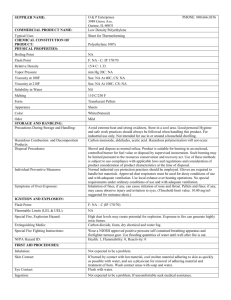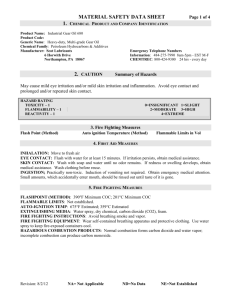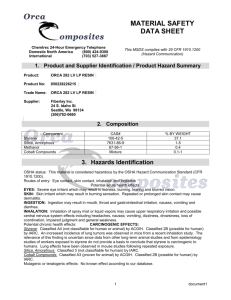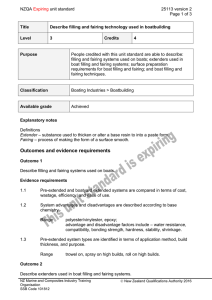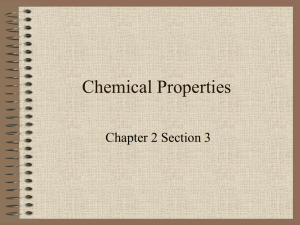MSDS - Fiberlay
advertisement
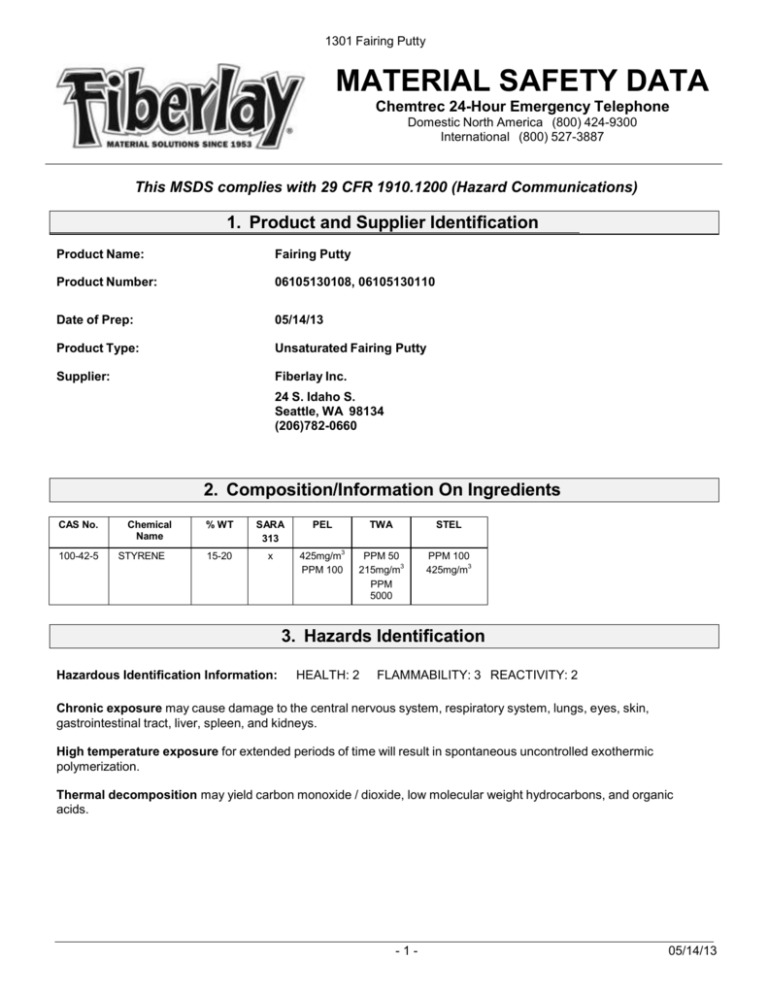
1301 Fairing Putty MATERIAL SAFETY DATA Chemtrec 24-Hour Emergency Telephone Domestic North America (800) 424-9300 International (800) 527-3887 This MSDS complies with 29 CFR 1910.1200 (Hazard Communications) 1. Product and Supplier Identification Product Name: Fairing Putty Product Number: 06105130108, 06105130110 Date of Prep: 05/14/13 Product Type: Unsaturated Fairing Putty Supplier: Fiberlay Inc. 24 S. Idaho S. Seattle, WA 98134 (206)782-0660 2. Composition/Information On Ingredients CAS No. 100-42-5 Chemical Name STYRENE % WT SARA 313 PEL TWA STEL 15-20 x 425mg/m3 PPM 100 PPM 50 215mg/m3 PPM 5000 PPM 100 425mg/m3 3. Hazards Identification Hazardous Identification Information: HEALTH: 2 FLAMMABILITY: 3 REACTIVITY: 2 Chronic exposure may cause damage to the central nervous system, respiratory system, lungs, eyes, skin, gastrointestinal tract, liver, spleen, and kidneys. High temperature exposure for extended periods of time will result in spontaneous uncontrolled exothermic polymerization. Thermal decomposition may yield carbon monoxide / dioxide, low molecular weight hydrocarbons, and organic acids. -1- 05/14/13 1301 Fairing Putty-06105130108, 06105130110 4. First Aid Measures Route(s) of Entry: Inhalation, Ingestion, Skin and Eye contact. Effects of Overexposure: Eye Contact: Severe irritation, redness, tearing, blurred vision Skin Contact: Prolonged or repeated exposure can cause moderate irritation, de-fatting, dermatitis, and sensitization. Inhalation: Excessive inhalation of vapors can cause nasal and respiratory irritation, dizziness, weakness, fatigue, nausea, and headache. High concentrations may result in narcosis (central nervous system depression). Ingestion: Can cause gastrointestinal irritation, nausea, vomiting and diarrhea. Aspiration of material into lungs can cause chemical pneumonitis, which can be fatal. Chronic exposure may cause damage to the central nervous system, respiratory system, lungs, eyes, skin, gastrointestinal tract, liver, spleen, and kidneys. Signs and Symptoms: Skin, eye and respiratory tract irritation. Emergency and First Aid Procedures: SKIN CONTACT: Remove contaminated clothing and wash affected area with soap and water. If irritation continues, seek medical attention. EYE CONTACT: Flush eyes with water for at least 15 minutes and contact a physician. INGESTION: Do not induce vomiting. Call a physician. INHALATION: Remove person to fresh air. If person is not breathing give mouth-to-mouth resuscitation and contact a physician. 5. Fire Fighting Measures Flash point: (Styrene) 90°F PENSKY-MARTEN CLOSED CUP Lower Explosive Limit: 1.10% Upper Explosion Limit: 6.10% Fire Extinguishing Media: Foam, carbon dioxide or chemical firefighting apparatus. Special Fire Fighting Procedures: Cool tanks and drums with water. Firefighters should wear self-contained breathing apparatus and protective clothing. Unusual Fire and Explosion: High temperature exposure for extended periods of time will result in spontaneous uncontrolled exothermic polymerization 6. Handling and Storage Precautions to be Taken: Store in a cool, dry place away from oxidizers. Do not store in direct sunlight. Work with adequate general and local exhaust ventilation to minimize exposure to vapors. -2- 05/14/13 1301 Fairing Putty-06105130108, 06105130110 Other Precautions: Avoid skin and eye contact. 7. Exposure Controls, Personal Protection Ventilation Requirements: Local exhaust ventilation should be used to control the emission of air contaminates. General dilution may assist with the reduction of contaminate concentrations. Personal Protective Equipment: Protective Gloves: Polyvinyl alcohol gloves and polyethylene garments are recommended Eye Protection: OSHA compliant goggles or face shields recommended. Other Protective Clothing, Equipment: Emergency eye wash stations should be located in the work areas. 8. Physical and Chemical Properties Boiling Point: 293°F Melting Point: NA Vapor Pressure (mm Hg.): 3.56 MM Hg Solubility In Water: N/A Vapor Density (AIR = 1): 2.98 Specific Gravity: 0.70 Percent Volatile by Volume (%): 12-16 9. Stability and Reactivity Stability: Stable under normal conditions. Avoid exposure to temperatures above 100°F or 38°C. Incompatibility (Materials to Avoid): Avoid contact with strong mineral acids, peroxides, oxidizing agents, and polymerization catalysts. Decomposition/By Products: Thermal decomposition may yield carbon monoxide / dioxide, low molecular weight hydrocarbons, and organic acids. Hazardous Polymerization: Can occur 10. Toxicological Information IARC (International Agency for Research on Cancer) has re-classified styrene from a Group 3 substance to a Group 2B substance. This is not based on any significant new evidence that styrene might be carcinogenic, but rather on a broadening of the definition for Group 2B classification. 11. Disposal Considerations Waste must be disposed of in accordance with federal, state and local environmental regulations. -3- 05/14/13 1301 Fairing Putty-06105130108, 06105130110 12. Regulatory Information TSCA Inventory Status: This substance or mixture appears on the Toxic Substance Control Act (TSCA) Inventory. SARA Hazard categories (section 311 and section 312): Reactivity, Immediate Health, Delayed Health, Fire. Hazardous Material Identification System: Health: 2 Flammability: 3 Reactivity: 2 NFPA Rating (Nat’l Fire Protection Association) Health: 2 Flammability: 3 Reactivity: 2 13. Other Information Preparation Date: 05-14-13 Prepared by: Fiberlay Inc. Comments: This Material Safety Data Sheet was prepared using information provided by Fiberlay Inc. Manufacturer Disclaimer: This information is furnished without warranty, expressed or implied, except that is accurate to the best knowledge of Fiberlay, Inc. The data on this sheet relates only to the specific material designated herein. Fiberlay Inc. assumes no legal responsibility for use or reliance upon this data. Revisions: None -4- 05/14/13
